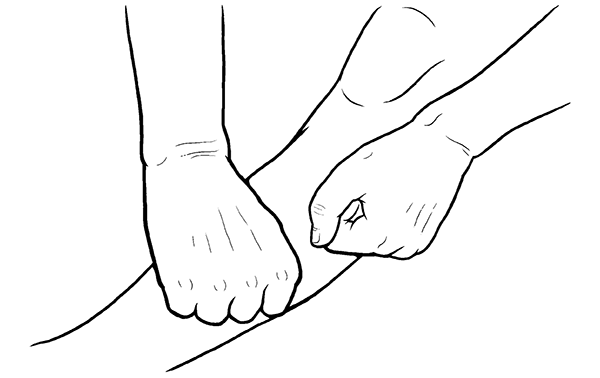Chinese Healing Exercises (8 page)
Read Chinese Healing Exercises Online
Authors: Steven Cardoza
Tags: #Taiji, #Qi Gong, #Daoist yoga, #Chinese Healing, #Health, #medicine, #remedy, #energy

4. Kneeling To e Stretch
This is a relatively strong toe stretch, and should only be attempted after your feet are open and soft from the previous exercises, to reduce any potential discomfort. Once this is learned, it may be combined with the Seated Forearm Stretch described in chapter 5, on shoulder and arm exercises.
Purpose
Physical:
Strongly stretches the muscles and ligaments of the toes; stretches the plantar fascia (at the sole of the foot).
Energetic:
Opens the Bubbling Well point, Kidney 1, and so benefits the Kidneys, strengthening bones, sexual/reproductive/urogenital functioning, and general vitality. The release of tension in the ligaments and fascia benefits the Liver, increasing calmness and physical and emotional balance. Improves grounding, being present. Helps to reverse some aging processes.
Techniques used
Stretching, Daoist yoga, focused breathing. If you are already experienced in daoyin, you can additionally benefit by using your mind to direct qi through your Kidney meridian.
Method
Kneeling with your knees close together, on a mat or other soft surface to protect your knees, position your feet so they are more or less perpendicular to the ground, toes pointed forward with the pads of the toes in contact with the ground. You may find your little toe curling, wanting to point rearward. If that's the case, use your hands to position your little toe (or any other that may need it) properly. Next, sit on your heels, putting more of a stretch on your toes
(
Fig 1.18
).
Keep your body as close to perpendicular as possible, hands placed palm down on your knees or thighs. The more you sit back on your heels, the greater the stretch becomes
(
Fig 1.19
).
Once you've reached the current limit of your stretch, where it just begins to be uncomfortable, use focused breathing to relax in that posture, releasing the discomfort along with any tension on each exhale.
Do not overdo this stretch, especially if you are new to it, or if it is particularly difficult for you. Ten or fifteen seconds may be a good place to start. Even when this stretch becomes completely comfortable, there is no need to do it for more than two minutes.


Figures 1.18 and 1.19 (Kneeling Toe Stretch)
Two
Leg, Seated
These exercises can be practiced on their own, or immediately following the foot exercises. They can readily begin where the foot exercises left off, and are practiced while seated on the floor.
The first two exercises in this series make use of paidagong, tapping and patting practices. In Chinese medical theory, one of the main causes of discomfort and pain, and one of the main factors considered to be at the root of many diseases when left untreated, is stagnation. In its milder phase, it is qi stagnationâenergy that should be flowing freely but is unable to do so, stuck in a location or many locations within the body. This could be due to physical or emotional trauma, inactivity, exposure to environmental conditions when prolonged or in a person sensitive to an environmental factor, inappropriate diet, or it could be a side effect of various drugs (prescription or otherwise), among many other possibilities. Over time, qi stagnation may worsen, weaken surrounding body tissues, and cause a stagnation of blood or other body fluids that should normally be in motion. These are more significant pathological changes engendering various diseases.
Paidagong can assist in reversing such stagnation. The gentle impact caused by tapping and patting induces a penetrating wave of energy through the body. When that wave encounters a pocket of stagnation, it can gradually break it up when applied over time, like a constant drip of water can wear down a boulder. As the stagnation breaks apart, any associated health problem will resolve.
These exercises are a good starting point for all that will come next. Even without a known health problem to remedy, the waves generated by tapping and patting gently relax and open the body, remove restrictions and make it easier to do the more challenging exercises.
1. Tapping and Patting the Outter Legs (Yang surfaces)
Purpose
Physical:
Relaxes and softens body tissues, promotes blood circulation in the legs, prepares the legs for later exercises.
Energetic:
Breaks up local qi stagnation, promotes qi flow through the Gall Bladder, Stomach, and Spleen meridians of the leg. The Spleen is one organ which engenders blood and thus assists in the physical purpose of this exercise. The Spleen and Stomach dominate the muscles, and the Gall Bladder (along with the Liver) dominates the tendons and ligaments, so this will energetically condition those body tissues.
Technique Used
Paidagong.
Method
Sit on the floor, legs extended in front of you. Curl the fingers of both hands into soft fists, not tightly clenched, with a little sense of space at the center of each palm. With any part of your fist that is easiest for you (back, sides, or front), use both to tap down one leg, starting at the thigh and slowly working your way down to your lower shin
(
Fig 2.1
).
Tap and pat down and up your leg a number of times. Vary the rate, rhythm, and force of the impacts, so your body won't be able to adapt to a repetitive pattern. While this is not crucial, it will enhance the benefit you get. Do not pat or tap strongly enough to hurt yourself. If you find any area of tenderness, stay on that area just a little longer than the others, since it indicates an area of stagnation that needs dispersing.
 Figure 2.1 (Tapping and Patting the Outter LegsâYang surfaces)
Figure 2.1 (Tapping and Patting the Outter LegsâYang surfaces)
Focus primarily on the top and outside of your leg here. We'll address the inner leg in the next exercise. While it's okay to tap on bony surfaces, it's more difficult to create that wave through bone, and you run a small risk of hurting yourself, so stick to the soft tissue for now. Do this for a few minutes on one leg, and then repeat on the other leg.
Variation
If you're unable to sit on the floor with your legs extended, or are unable to reach down to your lower leg, do this exercise seated in a chair, possibly with your foot resting on a footstool if necessary to reach your lower leg.
2. Tapping and Patting the Inner Legs (Yin surfaces)
Purpose
Physical:
Relaxes and softens body tissues, promotes blood circulation in the legs, prepares the legs for later exercises.
Energetic:
Breaks up local qi stagnation, promotes qi flow through the Spleen, Liver, and Kidney meridians of the leg. While equally important for men and women, these leg meridians treat a variety of women's issues, including various menstrual disorders and menopausal discomforts. Commonly, women will feel some tenderness at various places along these pathways. That's no cause for alarm, but does indicate a need for attention in those areas. In both sexes, they tone the urogenital system and can improve both sexual and general vitality. In men, the prostate is benefited.
Techniques Used
Paidagong, stretching.
 Figure 2.2 (Tapping and Patting the Inner LegsâYin surfaces)
Figure 2.2 (Tapping and Patting the Inner LegsâYin surfaces)
Method
Sit on the floor, with your legs positioned in one of three ways.
1. Place the soles of your feet together, and draw your heels to or to-ward your perineum. Your knees should be on or near the floor, with little or no discomfort to them or to your inner thighs.
(
Fig 2.2
)
This is the most advantageous position, since it stretches and opens the tendons, ligaments, and muscles in your legs, helps open your perineum, and gives you the best, easiest access to your inner legs. However, your legs should be comfortably relaxed. If they are not, choose one of the other seated modifications.
 Figure 2.3 (Tapping and Patting the Inner LegsâYin surfaces)
Figure 2.3 (Tapping and Patting the Inner LegsâYin surfaces)
2. Sit on a zafu or other firm cushion, and either place the soles of your feet together and drawn them toward your perineum as above, or cross your legs at or just slightly above your ankles
(
Fig 2.3
).
3. Sit on any comfortable cushion on the floor. If necessary, you can even sit on your bed. Use enough cushions or pillows under each knee to prop them up at a comfortable height, so your legs do not feel overstretched. Place your soles together at whatever distance is comfortable for you, or cross your legs at or slightly above your ankles
(
Fig 2.4
).
 Figure 2.4 (Tapping and Patting the Inner LegsâYin surfaces)
Figure 2.4 (Tapping and Patting the Inner LegsâYin surfaces)
Curl the fingers of both hands into soft fists as before. With any part of your fist that is easiest for you (back, sides, or front), use both fists to tap down the inner surface of one leg, starting at the thigh and slowly working your way down to your lower calf, just above your heel and behind your ankle (
Fig 2.2
â
Fig 2.4
on previous pages). It's also okay to start from this region and pat your way up to the top of your inner thigh, and you will want to tap and pat up and down your leg a number of times. Vary the rate, rhythm, and force of the impacts so that your body won't be able to adapt to a repetitive pattern. Do not pat or tap strongly enough to hurt yourself. If you find any area of tenderness, you should stay on that area just a little longer than the others, since it indicates an area of stagnation that needs dispersing.
Do this for a few minutes on one leg, and repeat on the other leg.
3. One-Leg Hamstring Stretch
Purpose
Physical:
Stretches all the muscles at the back of the leg. While mainly targeting the hamstrings, it also stretches the calf muscles (which includes the Achilles tendon, just above the back of the heel) and the low back. If more of your tension resides in those places, you may feel the stretch more strongly there.
Energetic:
Stimulates qi flow through the Urinary Bladder meridian, which runs up the back of the legs, and helps resolve qi stagnation in that portion of that meridian. This benefits the functions of the bladder, and can help to improve most urinary tract problems. With the inclusion of the Urinary Bladder here added to the paidagong exercises above, all regular acupuncture leg meridians are addressed.
Techniques used
Stretching, Daoist yoga, focused breathing.
Method
Sit on the floor with your left leg extended, the back of the knee very close to the ground without locking your knee, and the sole of your left foot placed as high up against your inner right thigh as is comfortable. If necessary, place a cushion under your right knee. Align your torso to face in the direction of your right leg, so that it is not twisted to the right or left. Keep your back straight, not bent or bowed, although it will incline forward when you follow the next instructions. With both hands, grab your right foot, and keep it held perpendicular to the ground, not tilted forward, left or right. Take a comfortable deep breath in, and while slowly letting it out, gently pull on your foot and incline your upper body toward your right leg
(
Fig 2.5
).
Do your best to keep your upper body directly aligned with your leg, not turned to the right (the most common mistake) or to the left, nor bent (curved or arched) forward. Repeat the breath and gently increase the stretch on the exhale. When you reach the place beyond which you can stretch no further, hold that stretch for five to ten slow, deep breaths, allowing yourself to relax into that stretch more fully with each exhalation. Then release your foot, place both hands at the sides of your left knee or slightly higher, and use them to push yourself back to an upright seated position, so you don't strain your back. Repeat the stretch on your right leg.
For extra benefit:
Put some attention on the back of your knee during this stretch, and see if you can specifically allow it to soften, release, and lengthen. The hamstrings cross the back of the knee and attach to the lower leg, so releasing the back of the knee will increase your hamstring stretch. For anyone already doing the neigong practice of pulsing body cavities and joint spaces, or for anyone already practicing the inner aspects of taiji and qigong and aware of the importance of keeping the backs of the knees open, this stretch and the next two that follow will aid in releasing any restrictions in the physical tissues, so those neigong aspects will become easier to attain. Additionally, opening the region around the entire knee benefits the He Sea points. He Sea points normalize the directionality of qi flow, especially as related to the Stomach and Intestines, and promote general vitality.
